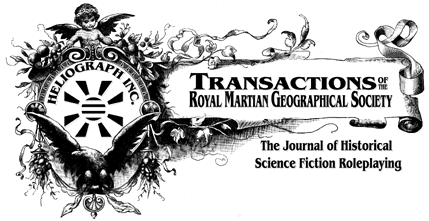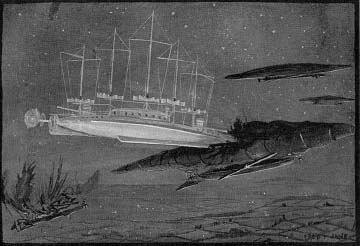
Buy | Submit | TRMGS1 | TRMGS2 | TRMGS3 | TRMGS4 |TRMGS Main | Heliograph Main
|
WHAT'S NEW?
The Complete Canal Priests Of Mars is now available!
The original publication of Canal Priests Of Mars cut slightly over a third of author Marcus L. Rowland's manuscript to fit GDW's adventure format.
The Complete Canal Priests Of Mars restores the cut material, features all new artwork by Paul Daly, and adds many useful player handouts. Enjoy the "author's cut" of a classic Space 1889 adventure, or experience it for the first time!
See our Buy It! page for more information!
Old news is still available on the News Page.
|
Sky Galleons of . . . Venus?!
Dirigible Battles Using the Sky Galleons of
Mars Rules
by James L. Cambias
On Venus, the imperial powers have begun using dirigibles, and
colonial ambitions inevitably create conflict. Dirigible battles can be
fought using Sky Galleons of Mars with a few minor changes.

Ithuriel vs. Russian Aerostats. Artwork by Fred T. Jane from Angel of the Revolution by George Griffith
Airship Design
Rules for hydrogen dirigible design are given in
Ironclads and Ether Flyers, and are very similar to the
Sky Galleons shipbuilding system. The difference is the hydrogen gasbag. Hydrogen can only be used
to create vessels of 200 or fewer tons (the Zeppelin works in
Germany can build airships up to 1000 tons). A gasbag costs £5000 per hull
size number. Rams may not be used.
Propulsion follows the Sky Galleons rules, but petrol-burning
engines are favored. In determining engine size it is useful to employ
fractional hull sizes. A 150-ton dirigible would count as hull size 1 1/2,
and consequently would need an engine of 15 tons to drive it at speed
6. Fuel consumption should also be worked out to fractional values.
In combat, however, hull size is rounded down to the nearest whole
number, so a 150-ton ship has Hull Size 1.
Armament follows the standard rules, but liftwood devices such
as Tether Mines or Smutts Torpedoes do not exist. Drogue Torpedoes
and Spike Droppers may be used normally. Incendiary devices are out of
the question.
Airship Combat
There are few differences between airship combat and the
Sky Galleons rules. Because a gasbag is so easily punctured, all shells
pass through the envelope without detonating, so all Hull hits inflict only
1 point of damage. Fires automatically destroy hydrogen airships. If
one catches fire at Low or Very Low altitude, the crew may try to ride
the flaming wreckage to a safe landing. Each crewman who rolls a 6 on
one die survives; the remainder perish.
The damage rules for targets at different altitudes are reversed
for airships, since the bulk of the hull is above the crew compartment
the reverse of the usual arrangement for liftwood flyers. If one fires at
a dirigible at a lower altitude, then all Crew hits count as Hull hits. If
one fires at a target which is at a higher altitude, then all hits are
resolved normally on the damage table.
Airships In Use On Venus
German Zeppelin Gunboat
Though flimsy compared with gunboats on Mars and Earth, the
Zeppelin is a veritable battleship on Venus. The armament is chiefly for
use against dinosaurs and Lizardmen. The German air fleet on
Venus includes four such vessels, the L ("Luftschiff")
-16, L-19, L-20, and
L-24.
The gunboat is a hydrogen-filled Zeppelin, hull size 2, with an
oil-fired steam engine of size 2 and a 40-day petrol supply. The ship
is armed with a 6-pounder Hotchkiss forward, three 1-pounder HRCs
sides and aft, and two Nordenfelts broadside. It has room for 8
passengers and 31 tons of cargo. The Zeppelin costs £13,060. It can reach
Very High altitude and has a speed of 6.
Italian Dirigible
The Italians have pioneered the semi-rigid dirigible, of which this is
a good example. It has a rigid keel along the base of the gasbag to
which the engines and gondola are attached. It is a multipurpose patrol
craft, not a warship. There is currently one such ship on
Venus, the Umberto.
The Umberto is a hydrogen-lift airship of 150 tons; the Hull Size is
1 1/2. It has an oil-fired steam engine and 30 tons of fuel (enough for
40 days). It is armed with two 1-lb. HRCs at the bow, one aft, and two
wing-mount Nordenfelts. It has space for 20 tons of cargo and 8
passengers. The ship can reach Very High altitude, has a Speed of 6, and costs £9,840.
Italian Patrol Blimp
This smaller craft is a nonrigid blimp; it is cheap and fast. The
Italians presently operate two blimps, the Roma
and the Venezia.
The blimp is Hull Size 1, with a total weight of 83 tons. It has an
oil-fired engine and carries 20 tons of oil (burning 1/2 ton per day).
The blimp mounts a 1-lb. HRC forward and has 3 Nordenfelts mounted in
the wings and aft. It can carry 13 tons of cargo and 6 passengers. The
ship can reach Very High altitude, has a Speed of 6, and costs £6580.
British Royal Navy Airship
The British have had difficulty translating their expertise in
liftwood flyer design to dirigibles. This blimp is essentially a copy of an
Italian design, but with heavier armament to offset
German power. The British have three blimps in their colony, the
NA.3 ("Naval Airship"),
NA.5, and NA.6.
The blimp is Hull Size 1, weighing 83 tons. It has an oil-fired
engine with 20 tons of fuel (burns 1/2 ton each day). Armament consists of
one 6-lb. HRC forward, one 1-lb. HRC aft, and two Nordenfelts in wing
mounts. The blimp carries 10 tons of cargo, and has space for 3
passengers. Maximum altitude is Very High; speed is 6; cost is £6640.
Russian Army Blimp
The Russian blimp sacrifices speed and altitude for armament
and carrying capacity. It can transport two squads of troops to a trouble
spot and provide fire support, or carry vital cargo. The
Russians currently have two blimps, the Alexander
and the St. Petersburg.
The Russian blimp is of Hull Size 1, weighing 100 tons. It has an
oil-fired engine of size 1/2, and 10 tons of fuel. The armament consists
of three 1-lb. HRCs at the bow and wings; and a single Nordenfelt aft.
The blimp has a 12-ton cargo hold and space for 15 passengers. It can
reach High altitude, and has a top speed of 3. Cost: £6320.
Scenario 1: Lines On A Map
In the spring of 1888, the Zeppelin
L-19 was sent to survey the Venusian Alps northwest of the Italian colony. The Italian governor
got word of the mission, and feared the Germans were trying to secure
a colonial claim in Italian territory. The newly-completed
Umberto and a patrol blimp were sent to chase away the L-19 and protect Italy's
rights to the area.
Rules: Use the mountain map from Sky Galleons of
Mars. The contour lines mark different altitude levels. The
Germans start at any height in the center of the map; the Italians enter from one side at any altitude.
Victory: The Italians win if the German ship is destroyed or
forced to leave the map. The Germans win if they withstand the Italian attack.
Scenario 2: Hearts and Minds
In August 1889, Russian and Italian blimps were sent to
establish relations with the coastal tribes north of the Hestia Highlands. Both
states hoped to overawe the natives with their flying ships. The two
blimps arrived within a week of each other, and the captains began shooting
at one another shortly thereafter.
Rules: Each side gets one blimp. The desert map is used,
ignoring surface features. The two ships enter from opposite sides of the map
at any altitude.
Victory: The victor must destroy his enemy and still be able to
return home. To return home an airship must have a working screw
and rudder, and must be able to reach Low altitude.
Scenario 3: Victory At Sea
William Sigerson, a British spy in the Italian colony, was
discovered and had to flee. With the help of sympathetic Lizardmen, he reached
the coast and sailed toward British territory. Sigerson was pursued by
the Umberto. In mid-ocean, however, a British blimp arrived just as the
Italians began to attack the raft.
Rules: The British get a blimp; the Italians get the
Umberto. Either map is used, ignoring surface features. A marker in the center of
the map represents the raft, which moves 1 hex toward the right-hand
edge each turn. The Italians start within 4 hexes of the raft at Medium
or higher altitude; the British enter one side of the map at any altitude.
Victory: The British win if they can finish one turn at ground
altitude on the raft (to pick up Sigerson) and leave the map, or else destroy
the Umberto. The Italians win if they sink the raft before Sigerson is
rescued, or destroy the blimp. To sink the raft, the Italians must score
a total of 30 hits on it.
Scenario 4: A Scientific Debate
The feud between Kaptanleutnant Freitag of
the L-19 and Lieutenant MacRoss of the
NA.5 began because both were amateur
naturalists. MacRoss repeatedly beat Freitag into publication with descriptions
of Venusian flora and fauna. Freitag claimed plagiarism. When the
L-19 encountered the NA.5 over German territory, Freitag decided to end
the feud once and for all.
Rules: Use the desert map. The contour lines mark different
altitude levels. The British get a blimp; the Germans get a Zeppelin. The
NA.5 begins at any altitude in the center of the map; the
L-19 enters at Very High altitude from the right-hand edge. The
German player automatically gets the initiative on the first turn.
Victory: The British player must escape off the left-hand edge of
the map, or destroy the L-19. The German player wins if the captain of
the NA.5 is killed.
Posted Monday, 04-May-2009 19:50:52 EDT
Return to Main Page
Comments to webmaster@heliograph.com
The material on this page is Copyright 2000 under the author or artist's name unless noted otherwise, and cannot be used without permission. This presentation Copyright 2000 by Heliograph, Inc. Space:1889 is a registered trademark of Frank Chadwick, all rights reserved, and is used with his permission. Most other game, movie, or book names may be trademarks of their respective holders, and use of a trademark at this site should not be construed as implying the sponsorship of the trademark holder, nor, conversely, should use of the name of any product without mention of trademark status be construed as a challenge to such status. Heck no! We love those guys.

